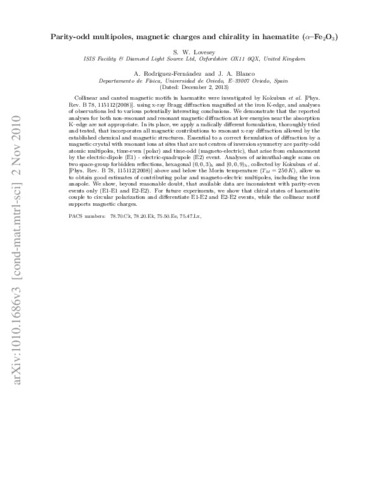Parity-odd multipoles, magnetic charges, and chirality in hematite α-Fe(2)O(3)
Autor(es) y otros:
Fecha de publicación:
Editorial:
American Physical Society
Versión del editor:
Citación:
Resumen:
Collinear and canted magnetic motifs in hematite were investigated by J. Kokubun et al. [Phys. Rev. B 78 115112 (2008) using x-ray Bragg diffraction magnified at the iron K-edge, and analyses of observations led to various potentially interesting conclusions. We demonstrate that the reported analyses for both nonresonant and resonant magnetic diffraction at low energies near the absorption K-edge are not appropriate. In its place, we apply a radically different formulation, thoroughly tried and tested, that incorporates all magnetic contributions to resonant x-ray diffraction allowed by the established chemical and magnetic structures. Essential to a correct formulation of diffraction by a magnetic crystal with resonant ions at sites that are not centers of inversion symmetry are parity-odd atomic multipoles, time-even (polar) and time-odd (magneto-electric), that arise from enhancement by the electric-dipole (E1)–electric-quadrupole (E2) event. Analyses of azimuthal-angle scans on two space-group forbidden reflections, hexagonal (0,0,3)h and (0,0,9)h, collected by Kokubun et al. [Phys. Rev. B 78, 115112 (2008)] above and below the Morin temperature (TM=250 K), allow us to obtain good estimates of contributing polar and magnetoelectric multipoles, including the iron anapole. We show, beyond reasonable doubt, that available data are inconsistent with parity-even events only (E1-E1 and E2-E2). For future experiments, we show that chiral states of hematite couple to circular polarization and differentiate E1-E2 and E2-E2 events, while the collinear motif supports magnetic charges.
Collinear and canted magnetic motifs in hematite were investigated by J. Kokubun et al. [Phys. Rev. B 78 115112 (2008) using x-ray Bragg diffraction magnified at the iron K-edge, and analyses of observations led to various potentially interesting conclusions. We demonstrate that the reported analyses for both nonresonant and resonant magnetic diffraction at low energies near the absorption K-edge are not appropriate. In its place, we apply a radically different formulation, thoroughly tried and tested, that incorporates all magnetic contributions to resonant x-ray diffraction allowed by the established chemical and magnetic structures. Essential to a correct formulation of diffraction by a magnetic crystal with resonant ions at sites that are not centers of inversion symmetry are parity-odd atomic multipoles, time-even (polar) and time-odd (magneto-electric), that arise from enhancement by the electric-dipole (E1)–electric-quadrupole (E2) event. Analyses of azimuthal-angle scans on two space-group forbidden reflections, hexagonal (0,0,3)h and (0,0,9)h, collected by Kokubun et al. [Phys. Rev. B 78, 115112 (2008)] above and below the Morin temperature (TM=250 K), allow us to obtain good estimates of contributing polar and magnetoelectric multipoles, including the iron anapole. We show, beyond reasonable doubt, that available data are inconsistent with parity-even events only (E1-E1 and E2-E2). For future experiments, we show that chiral states of hematite couple to circular polarization and differentiate E1-E2 and E2-E2 events, while the collinear motif supports magnetic charges.
ISSN:
Ficheros en el ítem




